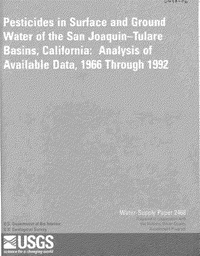Pesticides in surface and ground water of the San Joaquin-Tulare basins, California: Analysis of available data, 1966 Through 1992
Links
- More information: USGS Index Page (html)
- NGMDB Index Page: National Geologic Map Database Index Page (html)
- Download citation as: RIS | Dublin Core
Abstract
Available pesticide data (1966-92) for surface and ground water were analyzed for the San Joaquin-Tulare Basins, California, one of 60 large hydrologic systems being studied as part of the National Water-Quality Assessment Program of the U.S. Geological Survey. Most of the pesticide data were for the San Joaquin Valley, one of the most intensively farmed and irrigated areas of the United States. Data were obtained from the Storage and Retrieval data base of the U.S. Environmental Protection Agency, the water-quality data base of the U.S. Geological Survey, and from data files of State agencies.
Pesticides detected in surface water include organochlorine pesticides, organophosphate pesticides, carbamate pesticides, and triazine herbicides. Pesticides detected in ground water include triazine and other organonitrogen herbicides and soil fumi gants. Surface-water data indicate seasonal patterns for the detection of organophosphate and carbamate pesticides, which are attributed to their use on almond orchards and alfafa fields. Organochlorine pesticides were detected primarily in river-bed sediments. Concentrations detected in bed sediments of the San Joaquin River near Vernalis are among the highest of any major river system in the United States. Patterns and timing of pesticide use indicate that pesticides might be present in surface-water systems during most months of a year.
The most commonly detected pesticide in ground water is the soil fumigant, dibromochloropropane. Dibromochloropropane, used primarily on vineyards and orchards, was detected in ground water near the city of Fresno. Triazine and other organonitrogen herbicides were detected near vineyards and orchards in the same general locations as the detections of dibromochloropropane. Pesticides were detected in ground water of the east side of the valley floor, where the soils are sandy or coarsegrained, and water-soluble pesticides with long environmental half-lives were used. In contrast, fewer pesticides were detected in ground water of the west side of the valley, where soils generally are finer grained.
Study Area
| Publication type | Report |
|---|---|
| Publication Subtype | USGS Numbered Series |
| Title | Pesticides in surface and ground water of the San Joaquin-Tulare basins, California: Analysis of available data, 1966 Through 1992 |
| Series title | Water Supply Paper |
| Series number | 2468 |
| DOI | 10.3133/wsp2468 |
| Year Published | 1997 |
| Language | English |
| Publisher | U.S. Geological Survey |
| Contributing office(s) | California Water Science Center |
| Description | viii, 74 p. |
| Country | United States |
| State | California |
| Other Geospatial | San Joaquin-Tulare basins |
| Online Only (Y/N) | N |
| Additional Online Files (Y/N) | N |


